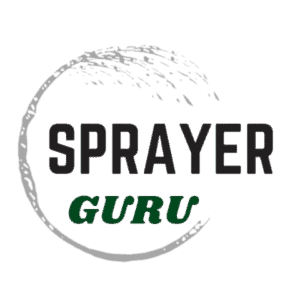There are hundreds of different types of spray nozzles. On the surface, it may seem the differences are arbitrary but the subtle variations can make a significant difference. Both in how effectively your sprayer covers your target and how safely and efficiently the liquid is dispersed. So although spray nozzles are small, they are a crucial component of any sprayer.
What’s The Difference Between Sprayer Nozzles?
Spray nozzles (also referred to as “spray tips”) are classified based on several characteristics that they have. The main characteristics that are different between different nozzle types are spray pattern, droplet size, and capacity.
Spray Pattern
Spray pattern refers to the shape and distribution of the liquid as it is dispersed from the spray nozzle. It impacts the coverage and penetration of the liquid being applied. The spray pattern is the primary distinguishing factor between the different types of spray nozzles.
Spray nozzles are typically named for both the shape of the spray pattern they produce and the angle of the pattern.
Different Spray Pattern Examples:
- Fan
- Cone
- Even fan
- Stream
- Off-center
The spray pattern is determined by the design of the nozzle. A spray nozzle will be designed to produce a spray certain spray pattern between a range of pressure.
For example, a flat fan nozzle with a 110-degree spray pattern might be designed to operate from 20-80 PSI. If the pressure is below 20 PSI, the spray pattern may not be full or consistent. Above 80 PSI and the spray can become a mist and the pattern is no longer even or effective.
Droplet Size
Droplet size is a critical factor in the application of herbicides, pesticides, and fertilizers. It refers to the size of the individual droplets that make up the spray pattern produced by a nozzle.
Droplet size impacts several aspects of spray application:
- Coverage: Smaller droplets create a finer spray, which can provide more thorough coverage on the target surface. This is particularly important when applying contact pesticides that need to cover the entire plant surface to be effective.
- Drift: Smaller droplets are lighter and more likely to be carried away by the wind, leading to spray drift. This can result in ineffective application, waste of chemicals, and potential harm to unintended plants, fields, etc.
- Penetration: Smaller droplets are better at penetrating dense crop canopies, reaching pests or diseases that may be underneath plant foliage.
- Evaporation: Smaller droplets are more prone to evaporation. This is a result of a greater surface area to volume. Evaporation of droplets before they hit their target greatly reduces the effectiveness of the spray.
The ideal droplet size depends on the specific application. For example, herbicides that are absorbed through the plant’s leaves may be best applied as a finer spray with smaller droplets, while herbicides that need to cover the soil surface may be better applied as a coarser spray with larger droplets. The label on the product you are spraying will often provide guidance on the droplet size to use.
Sprayer nozzles are designed to produce a specific range of droplet sizes, which is usually indicated by a color code. The actual droplet size can be adjusted by changing the pressure at which the spray solution is forced through the nozzle. For more information, be sure to read this article that shows the range of different droplet sizes.
Capacity (Nozzle Size)
Capacity or nozzle size refers to the flow rate of each nozzle. In other words how much liquid can be pushed through the nozzle at a given pressure.
Most nozzles are sized according to the flow that they can produce at 40 psi. Many nozzles, like flat fan nozzles, follow an international standard sizing, and the color code for the sizing is consistent from manufacture to manufacture and across different nozzle types.
There is a range of sizes for each different type of nozzle. For example, a flat fan spray nozzle and an air-inducted dual fan nozzle, can both be number for size nozzle. Meaning even though they are two different nozzle types that produce different spray patterns and droplet sizes, their flow capacity at 40 psi will still be the same.
Nozzle charts provide the specific flow capacity of each nozzle size at 40 psi. When you calculate the gallons per minute you need for your application, you can refer to these charts to identify the size you need.
Each nozzle type has its own advantages and disadvantages, and the choice of nozzle will depend on the specific application, the type of chemical or fertilizer being applied, the target pest or crop, and environmental conditions. It’s important to calibrate your sprayer regularly to ensure accurate and efficient application.
Spray Nozzle Material
Spray nozzles can be constructed from many different materials. The material a nozzle is made out of can significantly impact its durability, resistance to wear, and compatibility with fertilizers, herbicides, etc.
Here are several different variations of nozzle material types and their different applications:
- Stainless Steel Nozzles: These are durable and resistant to wear. They last longer than poly/plastic nozzles and brass nozzles but are more expensive. They are compatible with a wide range of agrochemicals, fertilizers, and other chemicals.
- Ceramic Nozzles: Ceramic nozzles offer wear resistance similar to stainless steel nozzles, however, they tend to wear more evenly over time. This helps maintain an even spray pattern. They are also resistant to chemical corrosion. However, they can be less durable than stainless steel.
- Plastic/Polymer Nozzles: Typically constructed from materials like polyacetal or polypropylene. These are the most common nozzle widely used in agricultural and turf spraying. They are resistant to chemical corrosion and are generally more affordable than stainless or ceramic nozzles. However, they tend to wear faster, especially when used with abrasive chemicals.
- Brass Nozzles: Brass nozzles are less common due to their lower wear resistance and chemical compatibility compared to the other materials. They are often used for low and medium-pressure applications with water or petroleum products.
Different Nozzle Types
Flat Fan Nozzles
Flat fan nozzles are one of the most commonly used types of nozzles in agriculture. They are designed to produce a fan-shaped spray pattern, which is ideal for providing uniform coverage over a wide area. These are specifically intended for use on boom sprayers of all different types.
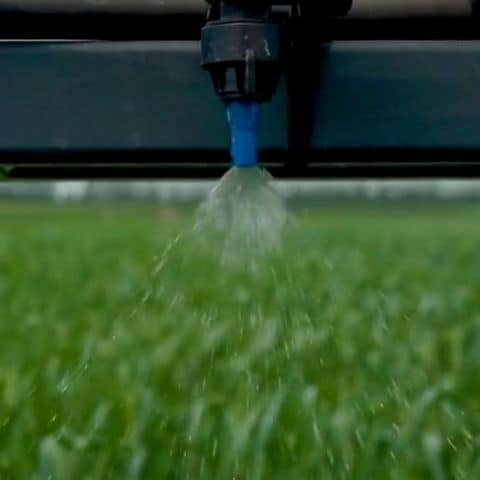
Spray Pattern
Flat fan nozzles produce a pattern that is tapered at the ends to allow for overlap with the spray patterns from adjacent spray nozzles. This ensures consistent coverage across the width of the spray boom. On agricultural boom sprayers, the angle of the spray pattern is usually between 80 and 110 degrees, although other angles are available for specific applications.
Flat Fan Nozzle Sizes
There is a standard international numbering system for flat fan spray nozzles. It provides a standardized way to identify the flow rate and spray angle of a nozzle. The first two or three digits represent the spray angle in degrees, while the last two or three digits represent the flow rate in gallons per minute at a pressure of 40 psi. For example, a nozzle labeled “11003” would have a spray angle of 110 degrees and a flow rate of 0.3 gallons per minute at 40 psi.
The size of a nozzle is indicated by a color code, according to the ISO standard. If you want to see the full color code, check out this article that covers nozzle sizing and numbering in more detail.
Usage
Flat fan nozzles are commonly used for applying herbicides, fungicides, and insecticides on cropland. They are also well suited for broadcast application of liquid fertilizers. They are uniquely effective for scenarios that require a thorough wetting of the plant surface or soil.
The use of flat fan nozzles requires an understanding of the factors that affect their performance. These include spray pressure, travel speed, and boom height. All of these variables affect the coverage and efficacy of the spray. Choosing the right nozzle size and determining the total output is a complicated topic that merits further discussion, and that is why I wrote an entire article on spray nozzle formulas that explains this in more detail.
It is also important to practice regular maintenance and cleaning of nozzles to ensure they continue to perform optimally and to prevent blockages or wear.
Flat Fan Nozzle Droplet Size
In terms of droplet size, flat fan nozzles generally produce smaller droplets that are more prone to drift, especially at higher pressures. Therefore, it is vital to understand the techniques and practices to minimize spray drift, particularly when applying herbicides or other chemicals that could potentially harm non-target plants or areas.
Different Types of Flat Fan Nozzles
- “Standard”: There is hardly a “standard” sprayer tip but one of the most commonly used sprayer nozzles is the Turbo TeeJet Flat Fan sprayer tip. It is available in 80 or 110-degree spray patterns and produces a fine to medium droplet size. This nozzle provides excellent coverage on surfaces but it is subject to drift.
- Extended Range: These are similar to the “standard” sprayer nozzle but they are designed to hold their spray pattern at lower pressures. This means they can be operated at a low PSI which means they develop slightly larger droplets to reduce drift potential. It also means they offer a wider range of travel speeds while still producing the same gallons per acre rate.
- Air inducted: Air-inducted sprayer nozzles, also known as venturi nozzles, are a type of spray nozzle designed to reduce to the number of small, drift-prone droplets by introducing air into the liquid as it exits the nozzle
- Dual Fan: These nozzles have two fans that are angled about 60 degrees apart, with one direct forward and one backward. The intent is that they can cover the plant or surface twice, while still using the same amount of liquid as the single fan nozzle. This is shown to provide better coverage. It has the added benefit of hitting plant tissue from two directions, getting coverage on areas a single fan would potentially miss.
- PWM: Abbreviation for Pulse Width Modulation, a technology used with agricultural sprayers to control the output of the spray nozzles. This technology allows for precise control of both spray rate and droplet size. It does require specific flat fan spray nozzles when using a PWM system in order to achieve the proper rate and develop the correct droplet size to be in compliance with local regulations.
- Even Spray Nozzles: Even pattern spray nozzles are a type of flat fan sprayer nozzle designed to deliver a uniform distribution of liquid across the entire spray pattern. This is different than standard flat fan nozzles that have a tapered pattern that delivers more liquid toward the center of the pattern.
Cone Nozzles
Cone spray nozzles are a type of spray nozzle used in the application of pesticides and fertilizers. They produce a cone-shaped spray pattern, which is ideal for providing thorough coverage over a wide area or a targeted spot.
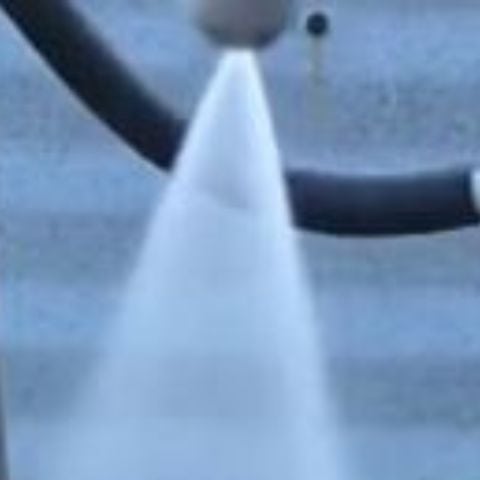
Different Types of Cone Nozzles
- Solid/Full Cone: A full cone nozzle produces a spray pattern that forms a complete circle.
- Hollow Cone: These cone nozzles produce a ring pattern.
Different Cone Nozzle Sizes
As with all the other nozzle sizes, there are different sizes available. They do not follow the same color code standard that flat fan sprayer nozzles conform to.
Cone Nozzle Uses
Cone nozzles can be used on spray booms or spray guns. They are ideal for spot spraying applications.
Off Center Nozzles
Off-center nozzles, also known as OC nozzles, are specialized types of spray nozzles designed to deliver a spray pattern that is not symmetrical. Instead, the spray is directed more heavily to one side. They are useful for spraying the edge of fields or areas adjacent to obstacles, such as fences, roads, or water bodies.
Off-Center Nozzle Sizes
Off-center nozzles are available in different flow capacities but they do not follow an international standard. Each manufacturer or brand will provide the specific flow rate information of their off-center nozzle options.
Usage
Off-center nozzles are typically mounted on the end of the boom, and they are oriented so that their spray pattern is disbursed beyond the coverage area of the boom. They do not overlap with other nozzles.
Flood Nozzles
Flood nozzles, also known as Floodjet nozzles (a TeeJet brand name), are designed to produce a wide, coarse spray pattern, often at lower pressures. They are typically used for applications that require a high volume of liquid over a large area.
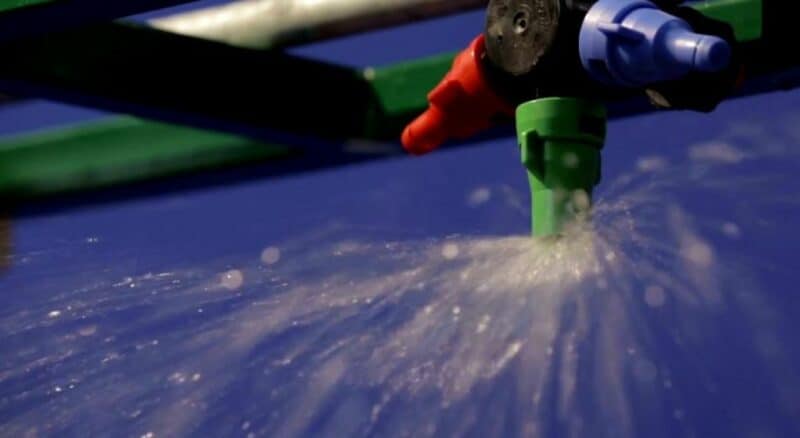
Spray Pattern
The spray pattern from a flood nozzle is usually wider and less uniform than that from a standard flat fan or even spray nozzle. This makes flood nozzles ideal for situations where heavy volume is more important than precise application.
Flood Nozzle Sizes
Flood nozzles are available in a wide range of sizes. They are often rated in gallons per acre for different speeds and spacings. They do not conform to the same standard color code as flat fan nozzles.
Different Flood Nozzle Types
Flooding nozzles are available in several different types. They vary in the width of the spray angle, how they mount to the boom and the volume of liquid that they will flow at a given psi.
Flood Nozzle Uses
Flood nozzles are often used for fertilizer applications. They are also used for herbicides that are soil applied. They also produce minimal drift.
Solid Stream Nozzles
A “solid stream” spray nozzle refers to a type of nozzle that produces a concentrated, narrow stream of liquid. The nozzle is often used in situations where precise placement of the fertilizer is required, such as in row crops.
Spray Pattern
The solid stream spray nozzle is different from other types of nozzles, such as flat fan nozzles or cone nozzles, which produce a wider spray pattern. The solid stream nozzle focuses the liquid into a concentrated stream, allowing for greater accuracy in application.
Solid Stream Nozzle Sizes
Solid stream nozzles are available in many different flow rates. They often follow the same sizing pattern as flat fan nozzles. For example, an 02 nozzle produces .20 gallons per minute at 40 psi. However, some different types do not follow this sizing.
Different Types
There are single solid stream nozzles or multiple stream nozzles. They provide different options for precise fertilizer placement. There are also variable rate solid stream nozzles. These provide a wide range of flow rates, allowing a farmer to apply different amounts of liquid to different areas of the field as needed without changing nozzles.
Usage
Fertilizer application is the most common use for solid stream nozzles, however, high-pressure versions are used for industrial cleaning and hydro excavation.
Boomless Nozzles
A boomless sprayer nozzle is a type of spray nozzle used in agricultural applications to distribute liquids such as fertilizers, herbicides, or pesticides, without the need for a traditional spraying boom. Unlike conventional sprayers that use a boom with multiple evenly spaced nozzles along a wide swath, boomless sprayers rely on one or two specialized nozzles to disperse the liquid in a wide pattern.
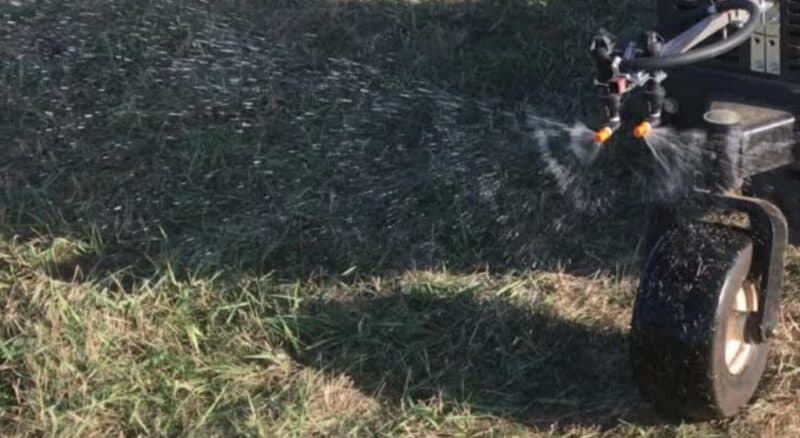
Boomless Nozzle Spray Pattern
The spray pattern of a boomless sprayer nozzle can vary depending on the specific design and settings. It typically produces a fan-shaped or cone-shaped pattern, effectively distributing the liquid over a wide area. Some boomless sprayer nozzles may feature adjustable spray angles or flow rates to allow for customization according to the application requirements.
Boomless spray nozzles have advantages such as increased efficiency, reduced equipment costs (as there is no need for a spraying boom), and simple operation. However, boomless sprayers may have limitations in terms of precision and uniformity of application. Boomless nozzle droplets are typically more coarse and due to the position from which the liquid is sprayed, tall plants or other obstacles can block the spray pattern.
Sizes
Boomless nozzles are available in a wide variety of flow capacities and spray widths. They are often rated in gallons per acre at different speeds.
Different Types
The biggest differences are the flow rate they can allow and the width they will cover. They can range from 3 ft to about 40 ft coverage from a single nozzle. They produce flow rates from 2 gallons per acre to well over 100.
Boomless Nozzle Uses
They are advantageous in situations where wide coverage is desired, such as when treating large open fields, pastures, or areas with irregular shapes that are challenging to reach with a conventional boom system. Boomless sprayers are commonly used in pasture and roadside weed management
If you are interested in learning more about boomless spray nozzles and boomless sprayers, be sure to read this article on the best boomless nozzles and how to build a boomless sprayer.
Spray Gun Nozzles
There are virtually endless applications for spray guns. Pesticide, driveway coatings, deck sealers, tree spraying, softwash, etc. So it is not a surprise that there are countless different types of spray gun nozzles. Like other spray nozzles, specific applications will require different spray patterns, capacities, and droplet sizes.
Different Types of Spray Gun Nozzles
- Adjustable nozzles
- Power wash nozzles
- Showerhead nozzles
- Cone
- Flat fan
- Long distance/tree spray nozzles
Uses
- Tree spraying
- Lawn spraying
- Pest control
- Cleaning
- Wood sealers
- Concrete coatings
- De-ice
- Dust control
Rinsing Nozzles
Rinse nozzles are specialty spray nozzles used to clean out and rinse out sprayer tanks, barrels, or other containers. They can be high-pressure or low-pressure. There is no governing standard for size or spray pattern. Again, they are highly specialized and often custom to specific application needs.
Different Types
- Rotary: The flow of water through these nozzles at a certain pressure will cause them to spin. This action helps evenly disburse water and thoroughly rinse out containers
- High-pressure: Some applications call for high pressure to rinse and clean out pipes, sewers, cisterns, etc.
- High-Volume: Moving sludge, mud, and other debris requires high volumes of liquid. These nozzles provide amounts much great than typical nozzles for other applications. Often 10 gallons per minute or more.
Uses
- Sprayer tank rinse out
- Sewer cleaning
- Industrial cleaning
Before You Go
Spray nozzles are a vital part of any sprayer or spray system. Although they are a small piece, in most cases they are they have the greatest impact on the effectiveness and capability of the sprayer. There are several different types and variations, sizes, etc. within each type.
It is worth it for anyone using a sprayer to learn the basics and understand the different types. Although there may not be a single exact nozzle for every application, knowing what the different types will do and what your specific requirements are will ensure you have one that meets your needs effectively and safely.
